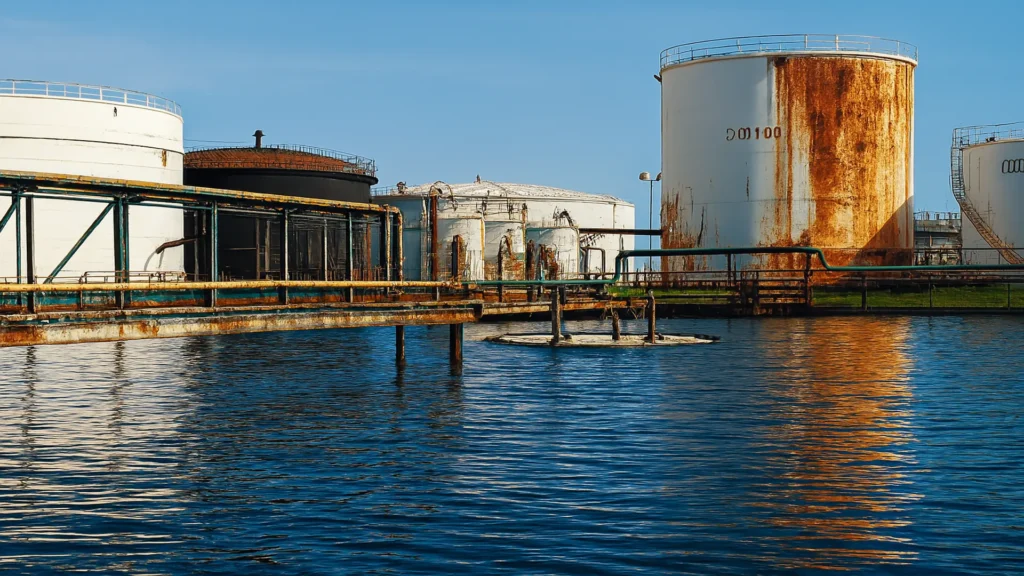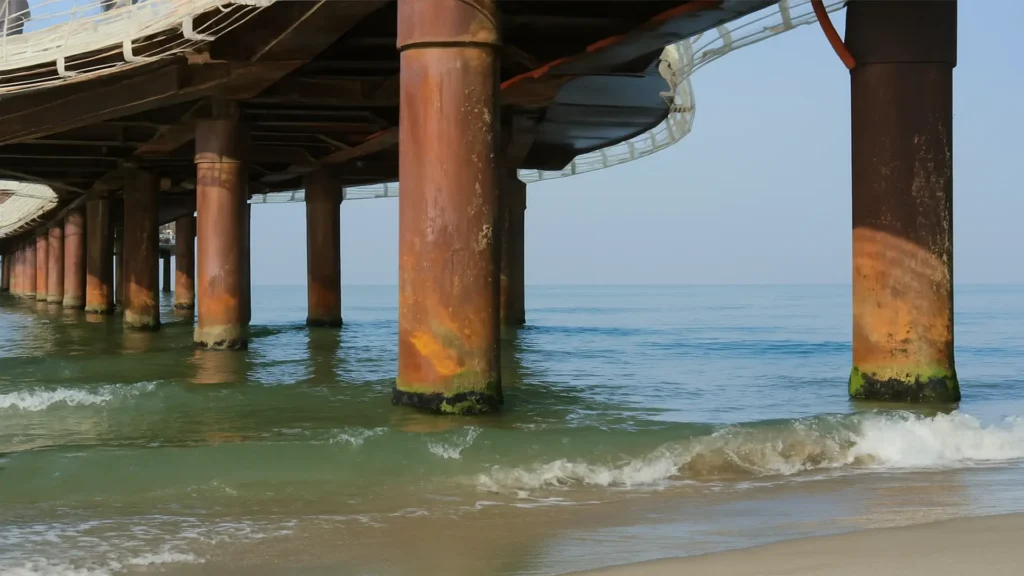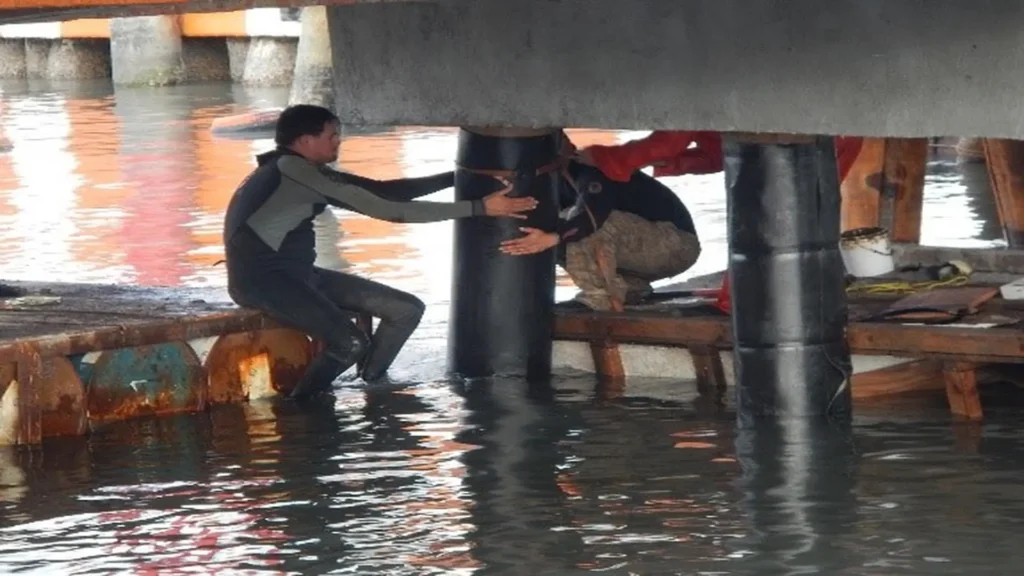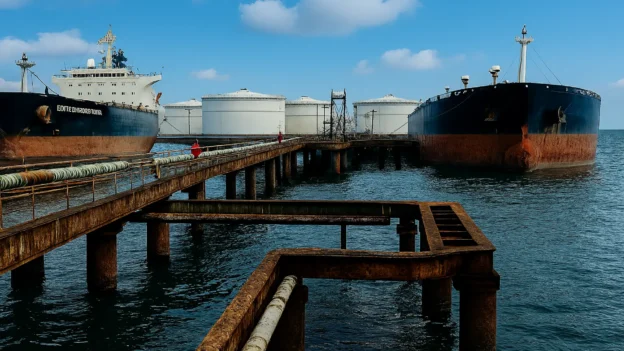Table of Contents
- Risk of corrosion in port terminals
- Environmental factors that accelerate corrosion in docks
- Localized corrosion on steel piles and walkways
- Cathodic protection and coatings in oil terminals
- International regulations and standards applicable to ports
- Recent cases and lessons learned in the industry
- Conclusions
- References
Corrosion at liquid product port terminals is a critical problem that compromises the safety, operational efficiency, and service life of strategic infrastructure. At docks and metal structures, deterioration caused by marine agents and oil spills creates a constant risk of structural losses and operational failures. This article addresses the main mechanisms of corrosion in port environments, the environmental and operational factors that accelerate damage, and the technologies and regulations that guide its mitigation.
The objective of this article is to analyze how corrosion develops in docks and metal structures at oil terminals, the environmental and operational factors that accelerate damage, the consequences for structural integrity, and the technologies and regulations that guide its mitigation.
Risk of corrosion in port terminals
Corrosion in port terminals for liquid products dedicated to the storage and handling of crude oil and crude oil derivatives is a complex phenomenon involving environmental, operational, and material factors. It represents a critical problem that compromises the safety, operational efficiency, and useful life of strategic infrastructure.
At docks and metal structures, deterioration caused by marine agents and oil spills creates a constant risk of structural damage and operational failures. Unlike other industrial infrastructure, ports face an aggressive environment characterized by high humidity, constant exposure to chlorides, and daily temperature variations. Added to this is accidental contact with hydrocarbons and sulfur compounds that generate highly severe corrosive microenvironments.
Environmental factors that accelerate corrosion in docks
Corrosion in port terminals is a complex process that combines physical, chemical, and environmental factors and mechanisms. It occurs mainly in metal structures exposed to seawater, the marine atmosphere, and, in many cases, oil spills. Factors such as high salinity, humidity, temperature variations, wave action, and the presence of contaminants accelerate the deterioration of metals. This phenomenon compromises the integrity of docks, piles, and pipes, as well as liquid storage tanks, leading to losses in structural capacity and increased risks of operational failures.

In addition, corrosion significantly increases inspection, repair, and maintenance costs, posing a critical challenge to the safety and sustainability of port infrastructure. Carbon steel piers and piles in contact with seawater are subjected to extremely aggressive conditions. High salinity and tidal cycles favor three critical areas: submerged, splash, and air-water interface. The latter, where the moisture film continuously forms and breaks, is considered the region of greatest attack.
The high concentration of dissolved oxygen combined with chlorides causes localized corrosion, loss of thickness, and accelerated weakening of piles, walkways, and support structures. The synergistic effect of atmospheric pollutants, solar radiation, and temperature changes increases the rate of deterioration compared to structures exposed only to industrial environments.
Effect of oil spills on metal structures
The risk of corrosion at terminals is not limited to the marine environment. Spills of crude oil, fuel oil, and derivatives during loading and unloading operations mix with seawater and sediments, creating deposits that adhere to metal surfaces. Under these layers, low-oxygen microenvironments develop that promote localized corrosion.
The presence of sulfur compounds in certain crude oils enhances sulfidation phenomena and generates areas of accelerated attack on pipes, piles, and support systems exposed to hydrocarbons. These processes are difficult to detect with the naked eye and often progress silently until they compromise structural integrity.
Localized corrosion on steel piles and walkways
The integrity of steel piles is one of the most critical issues in dock management. The splash zone presents a combination of abundant oxygen, concentrated chlorides, and wetting and drying cycles that accelerate the formation of deep pitting. These cavities can progress rapidly, reducing the resistant section of the steel in short periods of time.

On walkways and support beams, the combined action of dynamic loads, vibration, and salt moisture promotes stress corrosion, increasing the risk of sudden failure. The collapse of a walkway due to loss of thickness not only poses a human risk, but also has a high environmental and economic impact on port operations.
Cathodic protection and coatings in oil terminals
Corrosion control in marine terminals requires combined strategies. Cathodic protection, using sacrificial anodes or impressed current, is widely used on submerged piles and hydrocarbon transfer lines. However, its effectiveness depends on proper system design and constant monitoring of electrochemical potentials.
At the same time, thick epoxy and polyurethane coatings continue to be the first line of defense against atmospheric and splash corrosion. The challenge lies in surface preparation, as any deficiency in cleaning or application drastically reduces the coating’s service life. The combination of these systems, together with periodic inspections, is the most effective practice for preserving structural integrity in marine environments.

International regulations and standards applicable to ports
Corrosion management in terminals must be framed within recognized standards that guarantee structural safety. API 571 identifies the main mechanisms of damage in oil and gas facilities, while ISO 12944 establishes guidelines for coating systems in structures exposed to highly corrosive environments. PIANC (Guidelines for the Design of Marine Infrastructure), for its part, offers design guidelines for safe and durable marine infrastructure. The integration of these regulatory frameworks, together with risk-based inspection programs, allows for the prioritization of interventions and the optimization of resources in large-scale terminals.
Recent cases and lessons learned in the industry
Corrosion at liquid product port terminals, particularly in metal structures, docks, and oil tankers, continues to be one of the main challenges facing the maritime and energy industries. Documented experiences at terminals in the Gulf of Mexico and the North Sea have highlighted how the absence of continuous monitoring programs on piles, accelerated degradation of coatings in the tidal zone, and oil spills become critical factors that trigger premature failures.
In several of these cases, the presence of undetected localized corrosion has led to the loss of structural integrity in less than a decade of operation, forcing major repairs and, in extreme situations, the temporary suspension of operational activities with significant economic impact.
These experiences underscore the need to adopt predictive maintenance programs, supported by advanced monitoring technologies, including online corrosion sensors, remote inspection systems, and drones capable of assessing hard-to-reach areas. The integration of these practices not only extends the useful life of port infrastructure but also strengthens operational safety and reduces costs associated with corrective interventions.
Conclusions
Corrosion in port terminals is an inevitable phenomenon, but it can be controlled if appropriate protection and monitoring technologies and practices are applied. The combination of aggressive marine environments and oil spills accelerates the mechanisms of attack on piles, gangways, and metal structures.
The most effective mitigation methods are cathodic protection, high-performance coatings, and risk-based inspections, integrated into systematic maintenance programs. Industry experience shows that a lack of early attention can lead to severe structural failures with large-scale human, environmental, and economic consequences. Therefore, investment in corrosion control systems should not be seen as an operating cost, but as a guarantee of safety, sustainability, and continuity in the operation of oil terminals.
References
- API (2021). API RP 571: Damage Mechanisms Affecting Fixed Equipment in the Refining Industry. American Petroleum Institute.
- ISO (2018). ISO 12944: Paints and varnishes – Corrosion protection of steel structures by protective paint systems. International Organization for Standardization.
- NACE International (2020). Corrosion control in marine and offshore structures. Houston, TX.
- PIANC (2019). Guidelines for the Design of Marine Infrastructure. World Association for Waterborne Transport Infrastructure.

